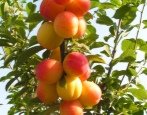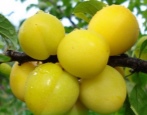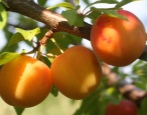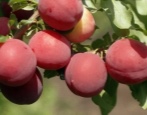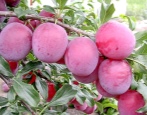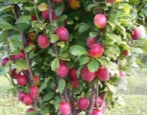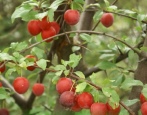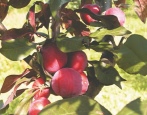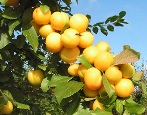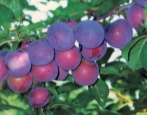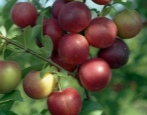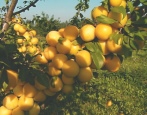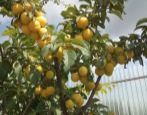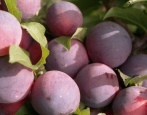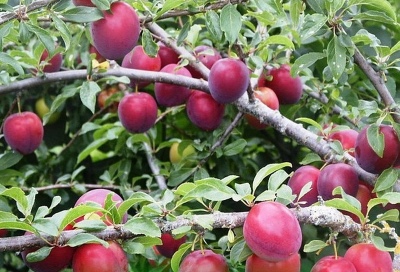
- Authors: Eremin G.V., Zabrodina S.N., Matveev V.A., Malyukevich M.P.
- Name synonyms: Prunus cerasifera Naidyona
- Appeared when crossing: Chinese plum Early x Russian plum Dessert
- Year of approval: 1993
- Growth type: medium-sized
- Ripening period: mid-early
- Self-fertility: self-infertile
- Fruit size: medium or large
- Yield: high
- Appointment: universal
Cherry plum is a fruit tree especially widespread in the Crimea. Gardeners have been growing such a tree for a long time, and managed to identify the most successful varieties. One of these is Nayden.
Breeding history
Found was developed by the joint forces of the Crimean Experimental Breeding Station of the All-Russian Research Institute of Plant Production. NI Vavilov and the Belarusian Research Institute of Fruit Growing. Eremin, Zabrodina, Matveev and Malyukevich took part in the experiment. The new variety was obtained by crossing the Chinese Skoroplodnaya plum and the Russian Dessertnaya plum. Tests of the qualities of the variety started in 1987, and already in 1993 the breeders achieved its introduction into the state register. A synonym for the name Found - Prunus cerasifera Naidyona.
Description of the variety
Found grows low - from 2.5 to 3 meters. The crown does not differ in increased thickening, its shape resembles a flat sphere.
The trunk of the tree has a standard thickness for cherry plum, it is straight, the bark on it is gray. Lentils are large, but there are quite a few of them.
The shoots of Found are rather thick, up to 4 mm in diameter, poorly branched and have a horizontal type of growth. The upper part of the shoot is green, and the lignified one is brown with a red tint. Bouquet branches grow actively, but their lifespan is maximum three years.
The foliage of the described variety is very large, oval in configuration. The base resembles a wedge, and the tip is characterized by the presence of a sharp tip. The foliage is painted in a light green shade, the surface of the plates shines beautifully. Crenate serration is observed along the edges of the sheets.
Ovaries Found without pubescence. The flowers have small petals, but there are quite a lot of stamens in them. The cup is shaped like a bell. The flowers are painted in a classic white shade, they smell strong.
Fruit characteristics
After flowering, Nayden forms medium to large fruits measuring 30x33 mm. The weight of a single specimen is about 30 grams. The main color of oval fruits is yellow, but the integumentary one will be red-violet. The resulting crop is covered with a medium layer of wax bloom.
On the fruit removed from the tree, numerous subcutaneous dots of yellow color are clearly visible, while there are not so many strokes on the surface. There is no abdominal suture at all.
Fruit skin found in medium thickness. It stretches well, and it is very easy to separate it from the fetus itself. A beautiful orange pulp with medium firmness is hidden under the skin. There are a lot of fibers in it, and the juiciness leaves much to be desired. It is difficult to separate the stone of medium size from the pulp.
Taste qualities
Fruits found when grown under the right conditions will be very sweet. The sourness is practically not felt, mainly the skin gives it. Jam, compotes and jam are made from the harvested crop. The fruits are very tasty and fresh. Expert assessment of taste - 4.3.
Ripening and fruiting
If Found is grown on a seed stock, then the first fruits can be expected for 2-3 years. Cherry plum blooms in April, blooms for about a week, sometimes a little more. By the timing of ripening Mid-early found, fruits clearly by the middle of the summer period. Harvesting is usually possible until the very end of July.
Yield
Plus Found - excellent yield. Each tree produces up to 50 kg of fruits, and fruiting is regular. Ripe fruits can hang for a long time without falling off, besides, they have decent indicators of transportability.
Growing regions
Found out for cultivation in the Central Black Earth Region and the Lower Volga regions. However, it can be grown not only here. Another variety takes root well in the Crimea, in most of the territories of Ukraine and Belarus.
Self-fertility and the need for pollinators
Failure to self-pollinate is one of the main disadvantages of this crop. However, it is easy to solve the issue by simply planting pollinators on the site. The best choice would be wild cherry plum. And you can also plant next to such varieties as Mara, Vitba, Traveler. If the site is very limited in area, then the problem is solved as follows: a branch is taken from one of the above species and simply grafted onto Naydenu.
Growing and care
Found - a very light-loving plant. The more it is in the sun, the sweeter its fruits are. The site must be protected from piercing winds. The soil requires fertile, well-conductive moisture. A good option would be forest gray soils, chernozem, rocky-gravel substrate. It should be borne in mind that the maximum proximity of groundwater to the surface is one and a half meters. Planting is carried out in early spring if the roots are open, and from April to mid-autumn if they are closed.
Drought resistance of the culture is average, therefore it is necessary to organize the correct feeding regime. If the precipitation is moderate, then you will have to water infrequently. So, this will definitely need to be done after the end of flowering, during the appearance of ovaries, as well as when pouring the fruits. The last watering is carried out after harvest.
If the weather is very hot and dry, the trees are watered more often; in the rain, on the contrary, irrigation is stopped. Seedlings of the first years of life are watered twice a month. The calculation of water is simple: a tree's life year is 1.5 buckets.
A couple of years after planting, they begin to give top dressing. In the spring, nitrogen is brought in, it will allow the cherry plum to quickly acquire abundant healthy foliage. Potassium is given in summer for the sweetness and quality of the fruit. In the fall, superphosphate is needed, which will help the trees survive the winter with ease. Once every three years, the soil is well fertilized with organic compounds.
Pruning Found are not difficult even for beginner gardeners. If the culture is own-rooted, then it is usually cultivated in the form of a bush. It is customary to form a grafted cherry plum with a bowl. The crown of Naydena is not particularly dense, so it practically does not need thinning pruning. But you need to carry out a sanitary one in the spring. Cherry plum begin to rejuvenate at the age of 10.
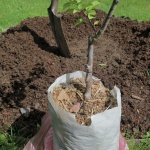
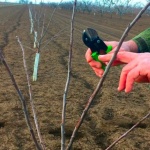
Disease and pest resistance
Found to cope well with various diseases and parasites. It is especially protected from clasterosporium disease. But preventative treatments should not be ignored. Gardeners recommend spraying Nayden in early spring with a mixture of fungicides and insecticides.
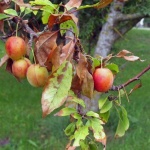
Requirements for soil and climatic conditions
The tree does not tolerate drought very well, so it must either be planted in regions with a stable climate, or constantly monitored in terms of irrigation. Cherry plum tolerates winters easily, provided it is sheltered. Before the procedure, be sure to collect the fallen leaves and do a deep digging of the soil. Further, the trunks are whitewashed and wrapped with sacking or other material. And also be sure to put a net from mice.

Review overview
Found - one of the best varieties of cherry plum, according to gardeners. The early culture produces delicious and beautiful fruits that can be used in cooking. The tree does not require difficult planting and maintenance, and does not exhibit a tendency to disease. Almost not attacked by pests.
However, some gardeners have had difficulty shaping. Without understanding the type of tree, gardeners formed it incorrectly, which caused low productivity and a decrease in the winter hardiness of the crop.

